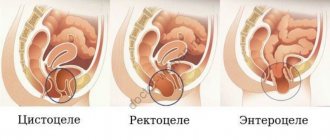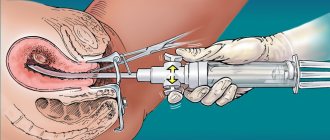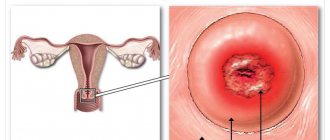Cells that have a violation of the structure and shape characteristic of the normal structure of a given tissue are called atypical.
Oncocytology smear (cytology smear, Papanicolaou test, Pap test) is a laboratory microscopic examination aimed at identifying atypical cells in the epithelium of the cervix.
Changed cells appear in the body constantly, but during normal functioning of the immune system they are destroyed in time.
However, the immune system does not always cope. In this case, the number of damaged cells can accumulate, forming areas of pathological tissue, which tends to degenerate into a malignant neoplasm.
Cervical cancer is characterized by the fact that if detected at an early stage, it can be completely cured. But the process of malignancy of the damaged area occurs quite slowly. It goes through three stages of the so-called precancerous condition or dysplasia. In this case, the normal structure of the mucous membrane is already disrupted, but there are no cancer cells yet.
Treatment of dysplasia, especially early ones, is quite gentle and effective. The woman's reproductive function is completely preserved. At the same time, dysplasia of all degrees, as well as cancer at an early stage, are completely asymptomatic. They are usually detected by cytological examination.
The Pap test allows you to detect all stages of disruption of the healthy structure of the organ mucosa - from early dysplasia to a pronounced oncological process. To avoid getting cervical cancer, little is required from a woman - take this test annually, regardless of the presence of complaints.
Our clinic offers all women to undergo screening, which is carried out using liquid cytology - it is an accurate method and provides a high level of reliability.
You can get tested as part of your annual visit to your gynecologist or come in separately for this test. In addition, it is recommended to be tested for carriage of the human papillomavirus. It is its oncogenic types - HPV types 16 and 18 that lead to cervical cancer in 70% of cases.
Smear for oncocytology - procedure
The cervix is a narrow, hollow tube, one end of which opens into the uterine cavity and the other into the vagina.
The epithelium adjacent to the vagina has a multilayer structure and is called “stratified squamous epithelium.” In the cervical canal the epithelium is cylindrical.
Pathological changes can affect both types of tissue; areas of altered epithelium can be very small. Therefore, in order for the analysis to reveal the true picture, it is necessary to qualitatively collect the material.
It is especially important that the area of the smear includes the junction of squamous and columnar epithelium - the zone of tissue transformation accounts for up to 90% of tumor processes.
For the reliability of the analysis, there must be a sufficient amount of material, since there may be few cells, which means there is a risk of them escaping from the inspection area. The extent to which these conditions are met depends on the professionalism of the doctor and the technique used.
Why is liquid cytology more reliable?
When using this method, the doctor uses a brush to perform a smear, which penetrates deeply into the tissue and covers all areas of the epithelium.
With the traditional method, the biomaterial is applied directly to the glass and dried, which reduces its quality.
When taking an analysis using liquid cytology, the brush is placed in a special preservative solution in which the cells retain their properties as much as possible. Thus, the material reaches the laboratory in its original form, which significantly increases the accuracy of diagnosis.
How to take a smear for oncocytology?
This procedure is usually performed by a gynecologist, but may be performed by a midwife or a specially certified nurse.
The patient lies down in the gynecological chair. The doctor places the brush in the external os of the cervix and makes a rotational movement, removing the epithelium from the walls of the organ. Then the brush is removed.
The manipulation is performed very carefully, it is completely painless, and the process itself lasts only 10-20 seconds.
A day or two after taking the test, vaginal discharge may increase. You shouldn't be afraid of this - it's normal.
How is cervical cytology taken?
This is part of a routine gynecological examination, which is recommended at least twice a year. The smear is taken on the chair with a special spatula and a soft brush, with which the biomaterial is applied to the glass plate. The procedure is painless. Takes about 10-15 seconds.
After taking the smear, you may experience mild discomfort, which will subside within 1-2 hours. On the day of the smear test, gynecologists recommend using a disposable thin pad, since minor discharge is possible.
Indications for a smear
Every woman should undergo an oncocytology test upon reaching 18 years of age, regardless of the presence of complaints - cervical pathologies, even at the stage of the early oncological process, can be completely asymptomatic.
Direct indications for performing a Pap test are:
- carriage of the human papillomavirus;
- pregnancy planning;
- infertility;
- genital herpes;
- uterine bleeding;
- upcoming installation of an intrauterine device;
- disruptions of the menstrual cycle;
- taking hormonal contraceptives;
- tendency to frequently change sexual partners;
- control of treatment of dysplasia and cancer.
When and how often should I have a smear for oncocytology?
For preventive purposes, screening is performed annually for the first 3-4 years. If during this period the results were normal, you can switch to a frequency of once every 3 years.
Women over 65 years of age do not need to perform the test if all previous results were negative. If a woman has been treated for dysplasia, cervical cancer, or is a carrier of HPV 16 or 18, a cytology smear should be taken regularly.
What else is prescribed with this study?
Antigen for squamous cell carcinoma (SCC) (carcinoma of the cervix, nasopharynx, esophagus, ear and other localizations)
8.14. Ven. blood 1 day
2,200 ₽ Add to cart
HPV 16/18/31/33/35/39/45/51/52/56/58/59 type, DNA (HPV, PCR, genotyping) scraping, count.
19.57. Scraping 1 day
1,700 ₽ Add to cart
Gynecological smear for flora
16.1. Scraping 2 days
620 ₽ Add to cart
How to prepare for a PAP test
To obtain an accurate result, proper preparation for analysis is important.
In order for the study to be most reliable, you should know when it is better to take a smear for oncocytology. This is best done between the fifth day of the menstrual cycle and five days before the start of the next menstruation.
What not to do before taking the test:
- Have sexual intercourse within 48 hours before.
- Use any intravaginal products - lubricants, suppositories, tampons, douching.
- Urinate 2-3 hours before the procedure.
It is not advisable to take a test during pregnancy. Severe inflammation can distort the result - it is better to cure the disease first.
How long does it take to prepare a smear for oncocytology?
The result of the analysis is known after 2-3 days, depending on when the material was delivered to the laboratory.
How long does it take to perform a smear for oncocytology?
- The material was delivered before 9 am - 2 pm.
- After 9 am – 3 days.
If you want to get results faster, make an appointment with your doctor early - preferably by 8 am.
What does an oncocytology smear show: normal and interpretation
A cytological study is aimed at identifying the pathology of cell structure, as well as the extent of the process.
There are several classifications of the results obtained. One of them was proposed by Dr. Papanicolaou, the inventor of the method.
What does an oncocytology smear show ? Interpretation of Papanicolaou tests:
- I – negative result . No atypical cells were found.
- II – inflammatory process.
- IIIa – first degree cervical dysplasia. There is slight atypia of the cellular structure of the epithelium. The changed cells cover less than 1/3 of the thickness of the organ walls.
- IIIb – moderate changes in cellular structure. The process extends to half or more of the thickness of the cervical mucosa.
- IIIc – pronounced pathology of the cellular epithelium of the organ, which covers 2/3 of its thickness.
- IV – malignant cells in the field of view. Suspicion of cancer.
- V – cervical cancer.
The interpretation of the smear for oncocytology should be carried out by a gynecologist. The test result is not a diagnosis.
With type I, everything is clear - a negative result means a completely healthy organ. It is also clear with IV and V - these are malignant processes. But, if a smear for oncocytology showed an inflammatory process or dysplasia, what does this mean?
The inflammatory process requires finding out its causes and treatment, and then retaking the test.
Important! The result of a cytological analysis in itself is not a diagnosis. A PAP test is a primary screening that provides the basis for further research. Diagnoses of “dysplasia” or “cervical cancer” can only be made based on histology results.
If a PAP test reveals dysplasia, they usually say “ a bad smear came for oncocytology.”
However, there is no reason for the disorder - dysplasia detected in time is treated. And even the third degree, in most cases, is not an indication for cervical amputation.
Dysplasia IIIa (initial) - the doctor can choose a wait-and-see approach and monitor the dynamics of the disease. As mentioned, atypical cells constantly appear in the body. In the initial stage of dysplasia, there is a chance that the body will cope with it without special intervention.
Treatment is provided for inflammatory gynecological diseases, hormonal disorders, and treatment for HPV.
After 3 months, the smear is repeated. If it is negative, the next one is performed after 6 months, and another after 12 months. Obtaining two repeated positive results requires in-depth examination and surgical treatment.
Dysplasia IIIb and IIIc immediately require further instrumental and laboratory examination.
Colposcopy is prescribed - examination of the cervix under a special microscope. This allows you to detect the lesion and take a piece of tissue from it for histological examination.
Depending on the result obtained, the doctor prescribes treatment. In case of dysplasia of the 2nd degree, destruction of the affected areas using a laser, low temperatures, electrocoagulation, or radio wave therapy can be prescribed. In the 3rd degree process, conization is most often performed - removal of the pathological area or cone-shaped amputation of the cervix. These surgical interventions are performed by gynecological oncologists.
Early stages of cervical cancer in a large number of cases allow only amputation of the cervix while preserving fertility. Removal of the uterus is indicated for severe cases of cancer.
When is it possible to get erroneous results?
Many laboratory tests may produce false positive or false negative results. The PAP test is no exception.
A false positive result indicates the presence of a pathological process when there is none.
This can occur with severe inflammation of the cervix. However, the degree of dysplasia shown will not be high.
A false negative result indicates the absence of cell atypia where it exists. This is a dangerous situation, since without treatment the pathological process will worsen.
Such errors can happen if the patient violated the rules for preparing for the test - for example, she used vaginal products or douched. This also happens when the material collection is unsuccessful. If the manipulation did not affect the affected area or little tissue was taken, atypical cells in this case will not fall into the field of view of the microscope and will not be detected. Dear women, take responsibility for your health - when preparing for the study, follow all the doctor’s recommendations and choose clinics that employ experienced professionals.
Happy stories
Polina
Sep 30 2021
Many thanks to your clinic and especially to Diana Omarovna!! IVF I got pregnant on the first try, my son is already 5 years old!!! I'll come again!!!
Read the story
Anna
28 Sep. 2021
We would like to express our deep gratitude and low bow to everyone who works in this clinic and, of course, to our doctor Aslanbek Ruslanovich Torchinov! On
Read the story
Svetlana
11 Sep. 2021
We would like to express our gratitude to the Fertimed clinic and in particular to the doctor from God Efimova Maria Sergeevna, she is our guardian angel thanks to her professionalism
Read the story
Sadovskaya-Shmeleva Tatyana Viktorovna
15 Jul. 2021
On May 4, 2021, a baby weighing 3150 grams and height 50 cm was born. This happiness cannot be expressed in words. Especially when the path to it is very long and difficult.
Read the story
Dzagoev family
May 03, 2021
Now I want to write my own story of happy motherhood. I have 9 years of infertility behind me, 4 IVF attempts, 3 of them were unsuccessful! 1 attempt was
Read the story
Svetlana
23 Feb 2021
I would like to express my deep gratitude to Tatyana Evgenievna Samoilova! Thanks to her, I am a happy mother! Our acquaintance began back in 2010, when
Read the story
Grineva Gulnaz
19 Feb 2021
I would like to express my deep gratitude to the doctor from God, Anna Anatolyevna Smirnova! It is thanks to her that we have been happy parents for five years now.
Read the story
Olga
23 Jan 2021
Our boy’s life began in Fertimed. Exactly 5 years ago they gave us his first photo, in it he was 8 weeks and 1 day old. What about us, future parents?
Read the story
Oksana
23 Dec 2020
I would like to express my gratitude to the MOON AND BACK to Diana Omarovna, Margarita Beniaminovna, Mikhail Yuryevich for our son, whose birth we are almost
Read the story
Natalia
29 Nov. 2020
I am 40, my husband is 49. We have a male factor, which makes it very difficult to get pregnant: most embryos stop on the 5th day of development. Except
Read the story
Elena
13 Nov. 2020
Our Moscow holidays were spent at the Fertimed clinic to fulfill our deepest desires. After endless attempts to get pregnant with...
Read the story
Marina
Oct 11 2020
It is impossible to express in words all the gratitude to our wizard - Torchinov Aslanbek Ruslanovich!!! Thanks to him, our baby was born on March 29, 2020.
Read the story
Irina
12 2020
I would like to express my deep gratitude to all the employees of this center for their professionalism. I would like to say a special HUGE THANK YOU to our doctor
Read the story
Orlova Olga Aleksandrovna and Chemodurov Dmitry Leonidovich
24 Jul. 2020
We would like to express our deep gratitude to all the doctors at this clinic! Thanks to you, we have two wonderful children growing up in our family - Zakhar (24.0
Read the story
Oksana
29 Jun 2020
Hello! We have an unusual story. My husband and I had our first children born in EB. Because We always wanted a very large family, so we decided not to stop..
Read the story
Evgeniya
May 16, 2020
My children are already 11 and 8 years old, but I periodically remember you with gratitude, dear Fertimed. Especially Anna Anatolyevna, Diana Omarovna, Margar
Read the story
Irina
17 Apr 2020
We owe our happy story to Anna Anatolyevna Smirnova! Thanks to her professionalism, our son was born. Anna Anatolyevna - they will notice
Read the story
Nikolai and Ekaterina
19 Feb 2020
Dear FertiMed, my wife and I want to sincerely thank the wonderful doctor, smart woman and great professional - Anna Anatolyevna Smirnova and sk
Read the story
Maria
10 Dec. 2019
Two years of unsuccessfully visiting doctors with my husband. We were advised to contact Zhordanidze Diana Omarovna in Fertimed. Wonderful doctor! Rezul
Read the story
Alipat
Oct 21 2019
Thanks to you, your clinic and Anna Anatolyevna Smirnova, I came to my cherished dream after 7 years of wandering from one doctor to another. Thankfully, I found out about
Read the story
Natalia
09 Oct 2019
I'll write a story too. 7 years of infertility, 3 IVF attempts. Out of desperation, I go and ask for a referral for laparoscopy. And in the intensive care unit I got into a conversation with a woman. TO
Read the story
Natalia
20 Feb 2019
Hello. I want to express my deep gratitude to your center. I got the impression of a close-knit team focused on results. Were treated by
Read the story
Andrey and Alexandra
14 Feb 2019
Many thanks from our entire large family to all the employees of the center for your work, for the smile on your face and faith in a positive result! Mihai
Read the story
Valentina
15 Jan 2019
My husband and I’s path to the happiness of being parents began in 2012 after the sounds of Mendelssohn’s wedding march died down. Like everyone else, we thought
Read the story
Catherine
May 16, 2019
After marriage, I couldn’t get pregnant at the age of 22; it turned out to be problems with the fallopian tubes. When I found out that I could never have anything on my own
Read the story
Olga
02 Mar 2019
I would like to express my deep gratitude to the FertiMed clinic, and especially to doctor Aslanbek Ruslanovich, for his good, caring attitude, and also for his
Read the story
Irina
23 Jun 2018
I would like to express my deep gratitude to the wonderful doctor of the FertiMed clinic, Aslanbek Ruslanovich Torchinov, for our long-awaited son. On hold
Read the story
Yuri
May 15, 2018
It will probably be an unusual review, since this is a review from a new father, and in general, I don’t really understand how I can express ours to you,
Read the story
Catherine
15 Dec. 2017
We first turned to FertiMed back in 2010, after 3 years of visiting doctors and undergoing all sorts of exotic tests. Unfortunately, the first
Read the story
Catherine
25 Sep. 2017
I got married at 22, my husband was 23, I never thought that there might be problems with conception, it turned out after I had appendicitis in childhood.
Read the story
Elena
May 23, 2017
My husband and I dreamed of having a child for 6 years. I have an adult daughter (20 years old) from my first marriage; my husband had no children. Passed several attempts at Eco in p.
Read the story
Elena
21 Feb 2017
My husband and I wanted more than anything to become parents, but time passed, wandering around to different doctors led to nothing, constant tests and treatment
Read the story
Nina and Peter
27 Sep. 2017
My husband looked at his spermogram as if it were a death sentence - not a single sperm count. And the reason is unclear. There was only one hope - for TEZU. It was explained to us that
Read the story
Faith
18 Jul 2016
I was ready to do anything to have a baby. By the age of 32, I had already undergone five operations on my ovaries and only one tiny piece remained from them. Nasty
Read the story
Maria
27 Jun 2016
I had two ectopics and no chance of having my baby. The irony was that my closest
Read the story
Valentina and Mikhail
Oct 14 2016
My husband and I flew from Kamchatka. They really wanted a second child. FertiMed was recommended by friends. They say that small and thin women like me have
Read the story
Sophia
27 Jul 2016
At FertiMed, at first they didn’t believe that I had 43 IVF attempts. There was clearly distrust and sympathy in the eyes of the staff - they say the woman went crazy.
Read the story
Alya
30 Sep. 2016
When I left my husband, with whom we had three children, no one, of course, could understand this, and no one wanted to. And even more no one could understand what m
Read the story
Valentina and Victor
01 Nov 2016
Our Dasha is growing up, at 1 year and 9 months she is a very smart girl, learning the alphabet on her own tablet (a real one, not a toy one)
Read the story
Christina
05 Apr 2016
I was 45 when I was ready for IVF. At the first meeting, the doctor at FertiMed said: there is no chance of having a child with my own eggs. At first there were sh
Read the story
Yana
13 2016
I am 29 years younger than my husband. He has three adult children, but I really wanted my child and ours together. Over the past few years, my husband has been very
Read the story
Anna
01 Mar 2016
I'm a happy mom! 5 years of standing with a birch tree, measuring basal temperature, tracking ovulation, hysteroscopy, laparoscopy (for my husband too), clostil
Read the story








